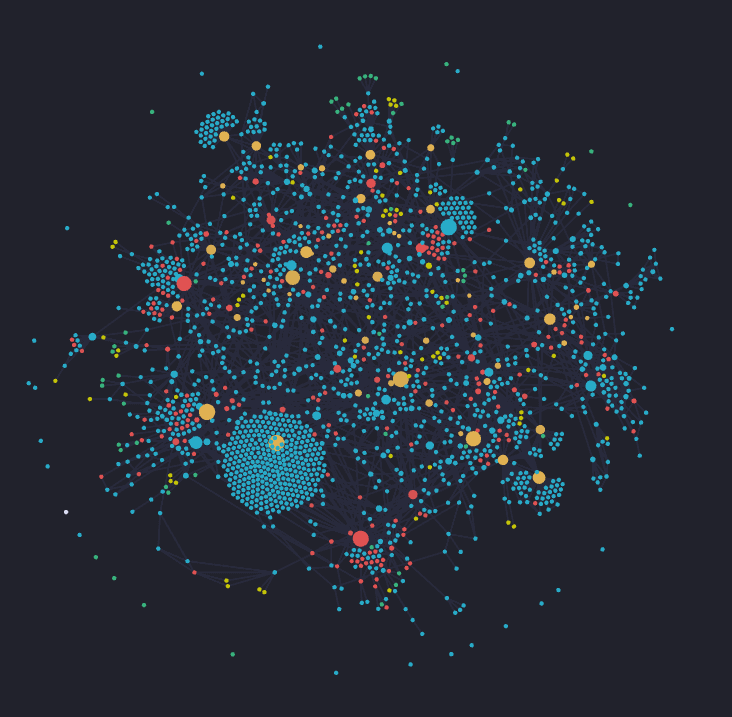Digital Gardening

A digital garden is a personal space where individuals can grow and organize their thoughts, ideas, and knowledge. Imagine it as a blend of a personal blog, an online notebook, and a personal Wikipedia. Unlike traditional blogs that prioritize publishing finished, polished posts, a digital garden is a collection of evolving notes, essays, musings, and ideas that are far more fluid, messy, and exploratory and aren't refined or complete—posts can be published as half-finished thoughts that will grow and evolve over time. They're less rigid, less performative, and less perfect than the personal "blogs" we're used to encountering on the web. Digital gardens are less about seeking approval or perfection and more about the ongoing process of learning, thinking, and exploring.
As knowledge workers, we are all constantly bombarded with information, a lot of good information too, but the challenge is absorbing it and applying it to the context of our lives and careers. In French, the phrase cultiver son jardin intérieur means to tend to your internal garden—essentially, to nurture your mind. Similarly, tending to your "mind garden" is a continuous process that involves cultivating your curiosity (the seeds), growing your knowledge (the trees), and producing new thoughts (the fruits). It is a repetitive process that will require consistency and patience. Just like a physical garden, your digital garden requires effort and care. It won’t be completed overnight. Instead, it grows in small, steady increments, reflecting the natural flow of learning and thinking, but each day will bring something new: a fresh insight, a different perspective, or a connection between seemingly different ideas.
Nature of a Digital Garden
Explorable, not linear
Digital gardens are designed for exploration. This runs counter to the time-based structure of traditional blogs: posts presented in reverse chronological order based on publication date. Rather, they are interconnected through rich links and context, allowing you to wander freely through your own forest of ideas. A garden’s structure is driven by relationships between concepts instead of the order in which the content was created. You can dive into any section, following trails and creating new paths along the way.
Slow Growth, Constant Evolution
Digital gardens don’t “finish” when they are published. They are meant to grow over time. The content is continuously revised and updated as your ideas develop. In this way, the garden reflects your intellectual journey, a living document that evolves alongside you.
This has a number of benefits:
- No pressure to be perfect: You’re free to experiment, test ideas, and revise them as they evolve. It’s a place for real-time feedback, discovery, and growth.
- Minimal friction: Tending to your garden becomes a daily habit. You can add new ideas, refine old ones, and watch your garden grow with minimal effort.
- Transparency in your process: Your readers get to see how your thoughts develop, offering them an authentic look into the messy, iterative nature of intellectual growth.
A Space for Imperfection
Unlike traditional blogs, where content is expected to be polished and final, digital gardens embrace imperfection. They allow you to post incomplete thoughts, experiment with new ideas, and even make mistakes. It’s both intimate and public, weird and welcoming. This is the concept of “learning in public”—sharing your evolving understanding rather than waiting until you’ve "mastered" a topic. It’s a more human and authentic approach to knowledge-building.
Playful, Personal, and Experimental
Just like real gardens, no two digital gardens are alike. You can plant the same seeds as your neighbor, but you’ll always end up with a different arrangement of plants. Digital gardens should be just as unique and particular as their vegetative counterparts. The point of a garden is that it’s a personal playspace. You organize the garden around the ideas and mediums that match your way of thinking, rather than off of someone else’s standardized template.
Independent Ownership
Digital gardening is about claiming a small patch of the web for yourself, one you fully own and control. While social media platforms like Facebook or Twitter may offer community and visibility, they aren’t designed to help you build and organize personal knowledge over time. In fact, most social platforms actively work against long-term knowledge building. None of them have an easy export button, and they certainly won’t hand you your data in a transferable format. If the platform disappears, your work could vanish with it. But a digital garden lives under your control, ensuring that your knowledge remains secure. Avoid walled gardens— create one that you fully control.
Collecting the dots
Creative research is not just about connecting the dots but about collecting them in the first place. We can only hold a tiny number of things in our brains at once. Your digital garden is the perfect space for gathering these dots and organizing them in a way that allows for deep, meaningful connections.
We consume content constantly— whether it’s blog posts, podcasts, books, videos, or tweets. Yet, without an organized space to store and reflect on what we consume, much of it fades into the background. Instead, as you consume content from blogs, podcasts, videos, and books, your garden serves as a place to plant these ideas so they don’t get lost. By rephrasing the content in your own words, you solidify your understanding and improve retention.
The Fertile Soil for Digital Gardening
The rise of digital gardening has been nurtured by a growing interest in personal knowledge systems, note-taking practices, and a shift away from the traditional, fleeting nature of social media. Many of the people who jumped on the early digital gardening bandwagon were part of communities like:
- The IndieWeb: A group advocating for independent web spaces outside the walled gardens of platforms like Facebook and Twitter.
- Users of the note-taking app Roam Research: This note-taking app pioneered the concept of interlinking ideas, appealing to people building sprawling knowledge graphs.
- Tiago Forte’s "Building a Second Brain": A course that popularized curating personal knowledge in a way that grows over time.
- Learn in Public: A philosophy of sharing your learning process as it unfolds, without waiting until you’ve "mastered" a subject.

There are today many tools available to build your own digital garden. Tools such as Obsidian, Notion, TiddlyWiki, and Roam Research feature powerful linking capabilities, nested folders, and visual graphs that allow for deep organization and exploration. However, digital gardening is not about specific tools; it’s a different way of thinking about our online behavior around information— one that accumulates personal knowledge over time in an explorable space.
The Appeal of Digital Gardens
Digital gardens offer a range of benefits, especially for those interested in personal knowledge management and creative exploration. Here’s why they’re worth considering:
Centralized Knowledge Management
Instead of scattering notes and insights across various platforms, a digital garden offers a single, organized space for all your ideas and references. Accessible from any device, it becomes your go-to repository for knowledge, ready to be added to and referenced whenever necessary.
Active Learning
Rather than passively consuming information, you're actively processing and connecting ideas in your digital garden. This leads to better retention and deeper understanding. By linking related ideas and concepts together, you build a web of knowledge that helps you see patterns, gaps, and insights you might not have otherwise noticed.
Boosting Creativity
The process of interlinking ideas can spark new insights and foster creativity. Your digital garden is a playground where you can experiment with different concepts, helping you see patterns and generate fresh ideas.
Productivity and Focus
By organizing your thoughts and knowledge, your digital garden helps you manage complex information. With everything in one place, you won’t waste time searching for the information you need. The mental load of remembering everything is reduced, freeing up cognitive space for more important tasks.
Personal Growth and Reflection
Over time, your garden becomes a record of your intellectual and personal growth. As you reflect on past entries, you’ll see how your thoughts, reflections, and challenges have evolved. You build a deeper understanding of your own thought patterns, interests, and goals.
Efficient Knowledge Retrieval
A well-organized digital garden enables quick access to relevant information, saving you time when you need to retrieve a specific piece of knowledge. With tags, categories, and linked references, it’s easy to find what you’re looking for.
Knowledge Sharing
Your digital garden can also be a space for sharing your insights with others. Whether it’s through public or private sharing, collaboration becomes a natural extension of your garden, inviting feedback and fostering community.
Long-Term Value
Unlike fleeting social media posts or one-time blog entries, a digital garden is a long-term investment. As you add to it, it becomes more valuable, serving as a rich repository of personal knowledge that grows with you over time.
Reducing Overwhelm
In a world flooded with information, a digital garden helps break things down into manageable pieces. It provides clarity and organization, making it easier to process large amounts of knowledge without feeling overwhelmed.
Keep Gardening
A digital garden is a work in progress—a living, breathing space where you can explore, learn, and grow your knowledge over time. It’s a place for personal discovery and intellectual play, free from the pressure to be perfect. So, just like with any garden, the key is consistency: keep planting new ideas, connecting them, and refining your thinking, and watch it grow. Over time, your digital garden will flourish to become a powerful, personal resource that reflects your intellectual journey and offers valuable insights for years to come.
Related concepts
- Personal Knowledge Management
- Building a second brain
- Intersectional thinking
- Knowledge Graphs
- Zettelkasten
- Learning in public
- Getting things done
Happy Gardening! 🌱